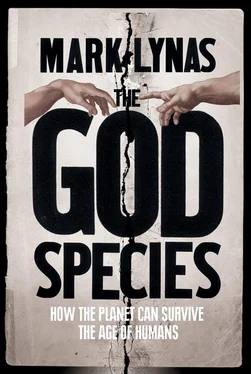Only one continent’s large animals survived relatively unscathed. That continent was Africa, whose megafaunal inhabitants had co-evolved with hominids over millions of years and had therefore acquired a great deal of useful experience about living with Homo sapiens . As a result, Africa gives us the best idea of what a pre-human landscape might have looked like, with big animals like elephants browsing the undergrowth and herds of wild horses and cattle stirring up dust clouds across the savannah. Indeed, African ecosystems have been used as a model for proponents of ‘rewilding’ parts of North America; if cheetahs, elephants and camels can be imported into places like Montana, perhaps they could assume the ecological niches vacated by their extinct relatives, some have suggested. 17 Конец ознакомительного фрагмента. Текст предоставлен ООО «ЛитРес». Прочитайте эту книгу целиком, купив полную легальную версию на ЛитРес. Безопасно оплатить книгу можно банковской картой Visa, MasterCard, Maestro, со счета мобильного телефона, с платежного терминала, в салоне МТС или Связной, через PayPal, WebMoney, Яндекс.Деньги, QIWI Кошелек, бонусными картами или другим удобным Вам способом.
This is a romantic but vain hope, not least because the ancient homeland of these large surviving animals is seriously endangered by today’s generations of human beings. Africa is safe no more.
Right across the world, these lost big animals left ‘ghost habitats’ behind – trees that still bear specialised fruits hoping some long-gone giant will distribute them, or thorny bushes protecting themselves against browsing by extinct large herbivores. In Brazil, more than 100 tree species still produce obsolete ‘megafauna fruit’, evolved for dispersal by extinct elephant-like creatures called gomphotheres. Not surprisingly, with no living animals to disperse their seeds, these trees are now themselves becoming endangered. In Madagascar many plants grow thin zig-zag branches to protect themselves from leaf-munching elephant birds, another giant flightless bird that became a casualty of Homo sapiens – and that laid eggs so large it is thought to have inspired the legend of the roc in Sinbad the Sailor . Modern-day Siberia’s wet peaty tundra may stem from the loss of the mammoths, whose earlier grazing nourished a much more productive dry steppe-type biome before their extinction at human hands a mere 2,000 years ago. 18 Конец ознакомительного фрагмента. Текст предоставлен ООО «ЛитРес». Прочитайте эту книгу целиком, купив полную легальную версию на ЛитРес. Безопасно оплатить книгу можно банковской картой Visa, MasterCard, Maestro, со счета мобильного телефона, с платежного терминала, в салоне МТС или Связной, через PayPal, WebMoney, Яндекс.Деньги, QIWI Кошелек, бонусными картами или другим удобным Вам способом.
In Africa elephants play a key role in opening up forests by pushing over trees – a function their relatives in the Americas would also have served before being wiped out by man. In all cases, the vanished megafauna maintained a more diverse ecosystem than the simplified one that replaced them after their sudden demise.
All told, the Quaternary Megafaunal Extinction between 50,000 and 3,000 years ago carried off about a half of the world’s large animals (including 178 species of large mammals). This was an extinction wave that bears comparison with the largest in the geological record – but it is still only a prelude to what was to come. The wipe-out that accompanied human migration across the continents was restricted only to the most large-bodied and easily targeted species. In comparison, today not only are the largest animals still at risk, but also small amphibians, songbirds, flowering plants, insects and much else besides. The Sixth Mass Extinction, or the Anthropocene Mass Extinction, is already well advanced – and the death toll will soon rival that at the end of the Cretaceous, when the dinosaurs (and half of the rest of life on Earth) disappeared. Today the small as well as the large wait in line for the cull.
THE SAD STORY OF THE SEA
Perhaps the ecosystem that has been most depleted of its animals in the modern era is the least visible one: the sea. Whilst disappearances on land are comparatively easily studied and recorded, what goes on beneath the waves is an enduring mystery, and humans have traditionally – and tragically – viewed the sea’s bounty as limitless. History once again provides a cautionary tale: the whaling industry, for example, managed to reduce cetacean populations once in the hundreds of millions to near-extinction in just a couple of centuries. The sheer scale of the effort was enormous: in the mid-nineteenth century, when many Atlantic whale species had already been exterminated, some 650 whaling ships operated in the Pacific, employing 13,500 seamen. 19 Конец ознакомительного фрагмента. Текст предоставлен ООО «ЛитРес». Прочитайте эту книгу целиком, купив полную легальную версию на ЛитРес. Безопасно оплатить книгу можно банковской картой Visa, MasterCard, Maestro, со счета мобильного телефона, с платежного терминала, в салоне МТС или Связной, через PayPal, WebMoney, Яндекс.Деньги, QIWI Кошелек, бонусными картами или другим удобным Вам способом.
Southern right whales saw their population reduced to as few as 25 breeding females by 1925, 20 Конец ознакомительного фрагмента. Текст предоставлен ООО «ЛитРес». Прочитайте эту книгу целиком, купив полную легальную версию на ЛитРес. Безопасно оплатить книгу можно банковской картой Visa, MasterCard, Maestro, со счета мобильного телефона, с платежного терминала, в салоне МТС или Связной, через PayPal, WebMoney, Яндекс.Деньги, QIWI Кошелек, бонусными картами или другим удобным Вам способом.
after nearly two centuries of devastating slaughter: a low-end estimate is that 150,000 were killed between 1770 and 1900.
Today the eastern North Atlantic right whales are marked as ‘critically endangered, possibly extinct’ on the IUCN Red List, whilst in the western Atlantic a population of about 300 individuals qualifies merely for ‘endangered’ status. 21 Конец ознакомительного фрагмента. Текст предоставлен ООО «ЛитРес». Прочитайте эту книгу целиком, купив полную легальную версию на ЛитРес. Безопасно оплатить книгу можно банковской картой Visa, MasterCard, Maestro, со счета мобильного телефона, с платежного терминала, в салоне МТС или Связной, через PayPal, WebMoney, Яндекс.Деньги, QIWI Кошелек, бонусными картами или другим удобным Вам способом.
Several are still killed each year by collisions with ships and through entanglement in fishing nets. As each species was destroyed in turn in its primary areas, the industry moved further afield, killing whales from Antarctica to the Galapagos Islands. Calving grounds were often targeted: congregating mothers could be killed while at their most vulnerable and calves captured too or left to starve. Each population was exploited to near-extinction. Most whales are slow-breeding, and with reproduction rates of 1–3 per cent per year the economically rational whaler would gain more benefit from driving the species to extinction and investing the profits elsewhere (to accumulate interest at perhaps 5 per cent a year) than leaving any alive in the sea. 22 Конец ознакомительного фрагмента. Текст предоставлен ООО «ЛитРес». Прочитайте эту книгу целиком, купив полную легальную версию на ЛитРес. Безопасно оплатить книгу можно банковской картой Visa, MasterCard, Maestro, со счета мобильного телефона, с платежного терминала, в салоне МТС или Связной, через PayPal, WebMoney, Яндекс.Деньги, QIWI Кошелек, бонусными картами или другим удобным Вам способом.
Such is the remorseless logic governing the unregulated capitalist exploitation of nature.
Читать дальше











